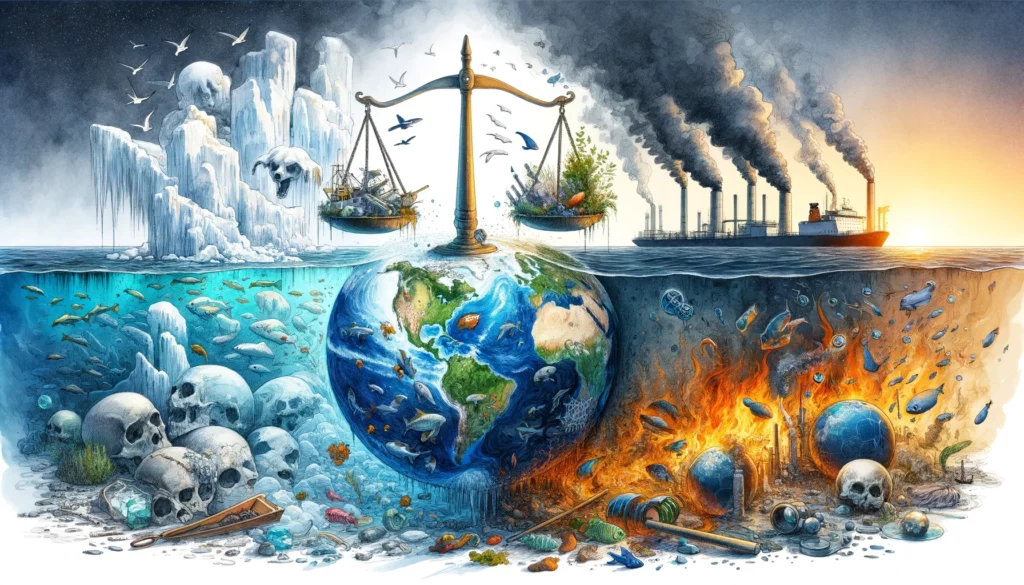Introduction
The Earth is facing an unprecedented environmental crisis, fueled by human activities. Among the myriad threats, one of the most alarming yet lesser-known dangers is the potential collapse of the Atlantic Meridional Overturning Circulation (AMOC), a key component of the Earth’s climate system. A recent study published in Science Advances has highlighted that the AMOC is approaching a tipping point, beyond which it may not recover, leading to catastrophic global climate changes.

The Role of AMOC in Earth’s Climate System
The AMOC is a critical conveyor belt of ocean currents that redistributes heat globally, influencing weather patterns, sea levels, and even the carbon cycle. It is powered by differences in water density, driven by temperature and salinity, facilitating a complex flow of warm and cold water across the Atlantic Ocean. This system is not just a component of the climate; it is a regulator, ensuring the balance that sustains various ecosystems and human economies.
Human Actions and the Destabilization of AMOC
Human activities, particularly greenhouse gas emissions, deforestation, and pollution, have led to global warming and an influx of freshwater into the oceans. This disrupts the delicate balance of the AMOC by decreasing the salinity and density of the water, essential for the circulation’s mechanism. The referenced study, utilizing advanced climate models, has shown that these changes are pushing the AMOC towards a critical tipping point, after which a collapse could ensue, with dire consequences.
Consequences of an AMOC Collapse
An AMOC shutdown would have profound effects on global climates, such as significant cooling in the North Atlantic, increased storminess, drastic changes in rainfall patterns affecting agriculture, and accelerated sea level rise on the East Coast of the United States. These changes would not only threaten biodiversity but also exacerbate food and water scarcity, leading to socio-economic instability.
The Unseen Dangers of Environmental Neglect
The potential collapse of the AMOC represents just one of the unseen dangers of environmental neglect. Other aspects include the loss of biodiversity, soil degradation, air and water pollution, and the accumulation of greenhouse gases. Each of these elements, often invisible in daily life, contributes to the destabilization of Earth’s systems and the worsening of the climate crisis.
Early Warning Signs and the Need for Action
The study on AMOC offers a new early warning system based on physics, providing a tool for scientists to predict the approach of the tipping point. This represents a critical advance in our ability to monitor and perhaps mitigate the most catastrophic effects of climate change. It is a clarion call for urgent action to reduce carbon emissions, protect natural habitats, and shift towards sustainable practices.
Global Efforts and Individual Actions
Addressing the unseen dangers to our planet requires concerted global efforts. International agreements like the Paris Accord represent steps in the right direction, but they must be matched by national, local, and individual actions. Reducing carbon footprints, supporting renewable energy, conserving water, and promoting sustainable agriculture are all crucial steps in the right direction.
The Role of Technology and Innovation
Innovation and technology play pivotal roles in combating environmental degradation. Advances in renewable energy, carbon capture, and climate modeling offer hope for mitigating the adverse effects of human activity on the planet. However, technology alone is not a panacea; it must be coupled with changes in behavior and policy that prioritize the environment.
Conclusion

The unseen dangers of mankind’s impact on the planet, exemplified by the potential collapse of the AMOC, are a stark reminder of the interconnectedness of Earth’s systems and the fragile balance we must maintain. While the challenges are daunting, understanding and addressing these threats is within our reach. It requires a collective commitment to sustainable living, political will, and innovation. Only through such concerted efforts can we hope to safeguard our planet for future generations.



